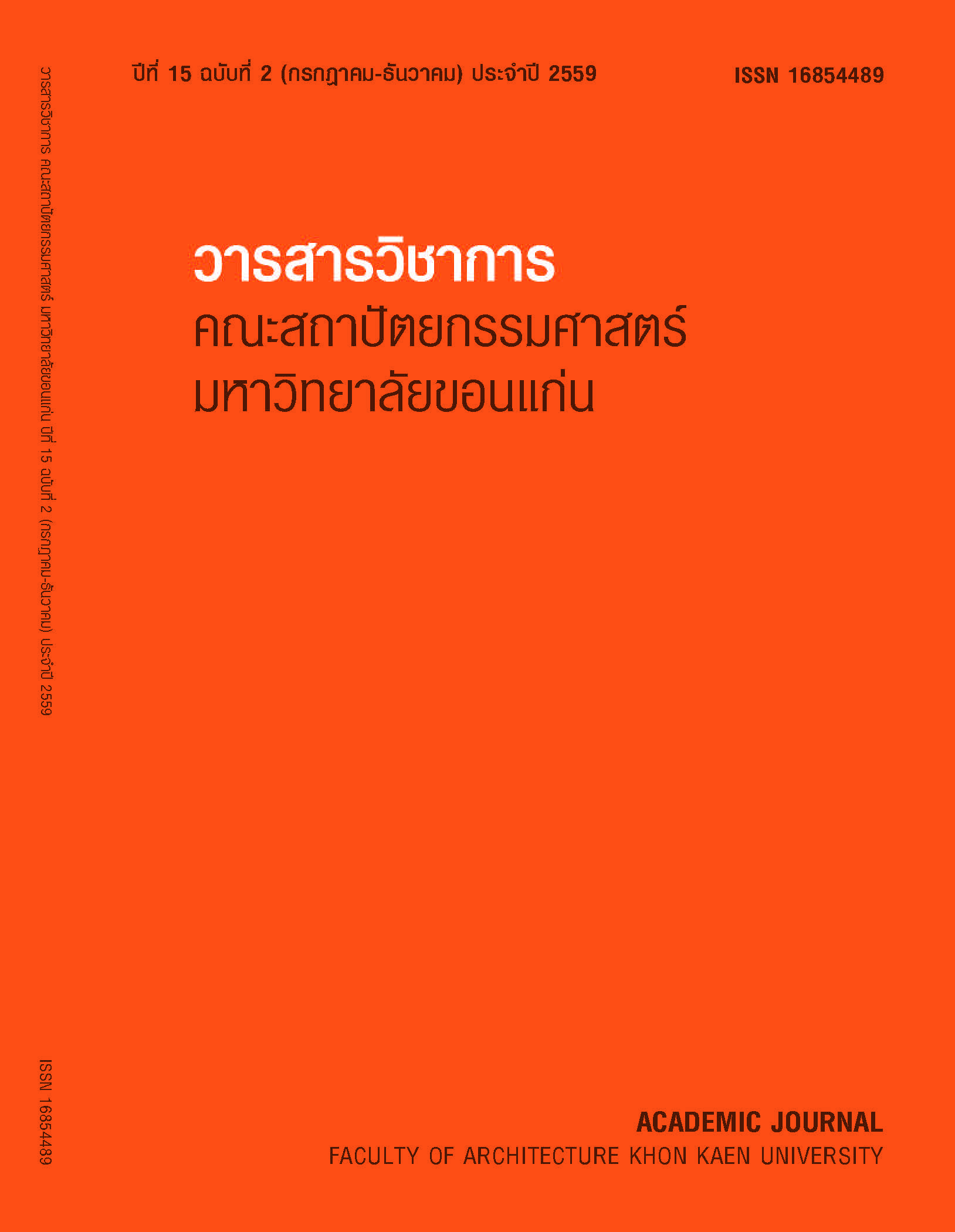การปรับปรุงฉนวนผนังยุ้งข้าวเพื่อลดการถ่ายเทความร้อนโดยการใช้วัสดุเหลือใช้ทางการเกษตร - The Thermal Reduction Improvement of Traditional Granary Wall with Argricultural Residual
คำสำคัญ:
ยุ้งข้าว, ฉนวน, การถ่ายเทความร้อน, วัสดุเหลือใช้ทางการเกษตร, Granary, Insulation, Heat Transfer, Agricultural Materialบทคัดย่อ
บทคัดย่อ
จากการสำรวจปัญหายุ้งข้าวในพื้นที่จังหวัดร้อยเอ็ด ซึ่งเป็นพื้นที่ทำการศึกษาพบว่ามีการใช้วัสดุผนังได้แก่
ไม้และสังกะสีเป็นหลัก ซึ่งการใช้ไม้มีแนวโน้มลดจำนวนลงเรื่อยๆ การใช้ผนังสังกะสีมีความนิยมมากขึ้นแทน แต่ทว่า
การใช้ผนังสังกะสีนั้นมีความไม่เหมาะสมกับการเก็บรักษาข้าวเปลือกเนื่องจากอุณหภูมิภายในค่อนข้างสูงในเวลา
กลางวันทำให้เมล็ดข้าวเปลือกเกิดความเสียหาย ผู้วิจัยจึงได้ทำการทดลองเพื่อปรับปรุงผนังยุ้งข้าวโดยใช้วัสดุผสมที่มี
วัตถุดิบเป็นวัสดุเหลือใช้ทางการเกษตรจำนวน 4 ชนิดที่มีในพื้นที่ ได้แก่ หญ้าแฝก แกลบ ฟางข้าว และดินเปี๋ย
(ดินเหนียวโบราณที่ใช้สำหรับการก่อสร้างผนังอาคารในอดีต ที่มีส่วนผสมของดินเหนียว 2 ส่วน เถ้าแกลบ 2 ส่วน
แกลบดิบ 1 ส่วน) เพื่อทดสอบเปรียบเทียบอุณหภูมิและความชื้นในเซลทดสอบและยุ้งข้าวจำลอง ผลการทดสอบทั้ง
สองส่วนพบว่าผนังสังกะสีที่มีการปรับปรุงด้วยการฉาบด้วยดินเปี๋ยมีความเหมาะสม เนื่องจากมีประสิทธิภาพในการ
ลดการถ่ายเทความร้อน และมีประสิทธิภาพในการป้องกันความชื้นได้ดีกว่าวัสดุผสมจากวัสดุเหลือใช้ชนิดอื่น
ABSTRACT
The survey study of this problem in Roi-Et province. The granaries of this area use wood
or galvanized sheet were used as a wall for the granaries in this area, but the use of wood decreases because of expensive cost. By this reason, the material from zinc was used to construct a granaries wall instead of wood, but the inside temperature was high because thermal conduction of this material. These zinc walls were improved usig agricultural residual material such as; vetiver grass, rice husk, rice straw, and “Pia” (the mixed material from clay, rice husk ash, and rice husk which used to construct the building in the past) and were tested in the test cells and simulated rice barns. The result shows that, the zinc wall improved by “Pia” was the most efficient way to reduce thermal transfer from outside and It could better reduce the humidity from outside than other residual materials for this study
ดาวน์โหลด
เผยแพร่แล้ว
รูปแบบการอ้างอิง
ฉบับ
ประเภทบทความ
สัญญาอนุญาต
ทัศนะและข้อคิดเห็นของบทความที่ปรากฏในวารสารฉบับนี้เป็นของผู้เขียนแต่ละท่าน ไม่ถือว่าเป็นทัศนะและความรับผิดชอบของกองบรรณาธิการ




